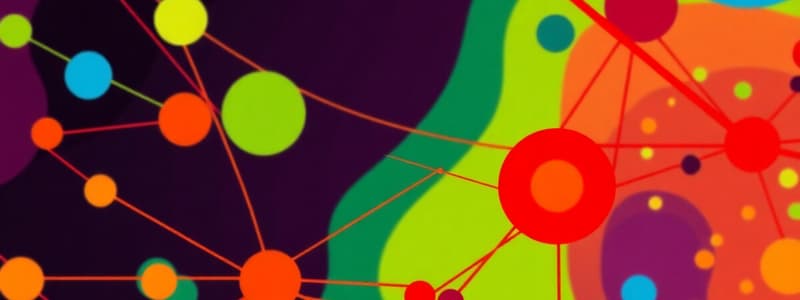Podcast
Questions and Answers
What is the definition of a computer network?
What is the definition of a computer network?
Two or more connected computers that share a resource such as data, a printer, an internet connection, applications, or a combination of these.
Which of the following are the three most common types of networks?
Which of the following are the three most common types of networks?
- Wireless Area Network (WAN)
- Metropolitan Area Network (MAN) (correct)
- Wide Area Network (WAN) (correct)
- Local Area Network (LAN) (correct)
- Internet Protocol (IP)
What is the main function of a Local Area Network (LAN)?
What is the main function of a Local Area Network (LAN)?
- To allow many users to access high-bandwidth media (correct)
- To connect geographically dispersed networks
- To connect devices within a limited geographic area (correct)
- To provide full-time connectivity to local services (correct)
What is the main difference between a Metropolitan Area Network (MAN) and a Wide Area Network (WAN)?
What is the main difference between a Metropolitan Area Network (MAN) and a Wide Area Network (WAN)?
How do bridges filter network traffic?
How do bridges filter network traffic?
A bridge can analyze incoming frames and forward them based on addressing information.
A bridge can analyze incoming frames and forward them based on addressing information.
Which of the following is NOT an advantage of the bus topology?
Which of the following is NOT an advantage of the bus topology?
What is the main function of a network hub?
What is the main function of a network hub?
What is the purpose of a network operating system (NOS)?
What is the purpose of a network operating system (NOS)?
What is the main advantage of the star topology?
What is the main advantage of the star topology?
What is the main disadvantage of the ring topology?
What is the main disadvantage of the ring topology?
What is the definition of bandwidth?
What is the definition of bandwidth?
What is the main function of the Transport Layer in the OSI reference model?
What is the main function of the Transport Layer in the OSI reference model?
Which of the following layers in the OSI model is responsible for addressing the communication between two systems that might be geographically separated network?
Which of the following layers in the OSI model is responsible for addressing the communication between two systems that might be geographically separated network?
What is the main purpose of TCP/IP?
What is the main purpose of TCP/IP?
What is the function of the subnet mask in IP addressing?
What is the function of the subnet mask in IP addressing?
What is the main difference between a straight-through cable and a crossover cable?
What is the main difference between a straight-through cable and a crossover cable?
Fiber-optic cable is more susceptible to electromagnetic interference compared to other networking media.
Fiber-optic cable is more susceptible to electromagnetic interference compared to other networking media.
What is the main purpose of a router?
What is the main purpose of a router?
What is the function of a patch panel?
What is the function of a patch panel?
What is the purpose of the Application Layer in the OSI model?
What is the purpose of the Application Layer in the OSI model?
Which of these is an example of an Application Layer service?
Which of these is an example of an Application Layer service?
What is the purpose of the Presentation Layer in the OSI model?
What is the purpose of the Presentation Layer in the OSI model?
Which of the following is a common Layer 6 standard for data formatting?
Which of the following is a common Layer 6 standard for data formatting?
What is the main function of the Session Layer in the OSI model?
What is the main function of the Session Layer in the OSI model?
The OSI reference model is considered a hierarchical model, with each layer building upon the services provided by the layer below it.
The OSI reference model is considered a hierarchical model, with each layer building upon the services provided by the layer below it.
What is the main advantage of using a layered approach to network communication?
What is the main advantage of using a layered approach to network communication?
The OSI reference model is a de facto standard, meaning it is widely accepted and used by network vendors and organizations.
The OSI reference model is a de facto standard, meaning it is widely accepted and used by network vendors and organizations.
What is the purpose of peer-to-peer networking?
What is the purpose of peer-to-peer networking?
Flashcards
Network
Network
A collection of interconnected devices, such as computers, printers, and other peripherals, that share resources like data, applications, and internet connections.
Local Area Network (LAN)
Local Area Network (LAN)
A network that spans a small geographical area, typically a building or a small group of buildings.
Metropolitan Area Network (MAN)
Metropolitan Area Network (MAN)
A network that spans a larger area, such as a city or a metropolitan region, connecting multiple LANs.
Wide Area Network (WAN)
Wide Area Network (WAN)
Signup and view all the flashcards
Bus Topology
Bus Topology
Signup and view all the flashcards
Star Topology
Star Topology
Signup and view all the flashcards
Ring Topology
Ring Topology
Signup and view all the flashcards
Mesh Topology
Mesh Topology
Signup and view all the flashcards
Repeater
Repeater
Signup and view all the flashcards
Hub
Hub
Signup and view all the flashcards
Bridge
Bridge
Signup and view all the flashcards
Switch
Switch
Signup and view all the flashcards
Router
Router
Signup and view all the flashcards
Unshielded Twisted Pair (UTP)
Unshielded Twisted Pair (UTP)
Signup and view all the flashcards
Shielded Twisted Pair (STP)
Shielded Twisted Pair (STP)
Signup and view all the flashcards
Screened Twisted Pair (SCTP)
Screened Twisted Pair (SCTP)
Signup and view all the flashcards
TCP/IP
TCP/IP
Signup and view all the flashcards
IP Address
IP Address
Signup and view all the flashcards
Subnet Mask
Subnet Mask
Signup and view all the flashcards
Peer-to-peer Networking
Peer-to-peer Networking
Signup and view all the flashcards
OSI Reference Model
OSI Reference Model
Signup and view all the flashcards
Physical Layer
Physical Layer
Signup and view all the flashcards
Data Link Layer
Data Link Layer
Signup and view all the flashcards
Network Layer
Network Layer
Signup and view all the flashcards
Transport Layer
Transport Layer
Signup and view all the flashcards
Session Layer
Session Layer
Signup and view all the flashcards
Presentation Layer
Presentation Layer
Signup and view all the flashcards
Application Layer
Application Layer
Signup and view all the flashcards
Study Notes
Network Topologies
-
Star Topology: Network fails if the central hub fails. Requires a device at the center to rebroadcast traffic. More cable is needed compared to other topologies.
-
Ring Topology: Each computer connects to the next, forming a ring. All computers retransmit received messages. Not susceptible to signal loss like a bus topology. Token passing is often used in ring networks. A token circulates until a device needs to send data, modifying the token to include the information and destination address.
-
Bus Topology: Heavy traffic slows the network down. Any computer can transmit at any time, without coordination. Loss of a cable or faulty device can disrupt the entire network.
-
Mesh Topology: Distinguished by redundant links between devices. Offers high tolerance to failure because of multiple paths for data transmission. Very expensive and difficult to manage.
LANs, MANs, and WANs
-
Local Area Network (LAN): Relatively small geographic area. Used for sharing files, printers, and making internal communication seamless. Connects computers in a business or building.
-
Metropolitan Area Network (MAN): Covers a larger geographic area than a LAN (e.g., a city). Connects multiple LANs within a metropolitan area.
-
Wide Area Network (WAN): Largest network topology, spans large geographic areas (e.g., across countries or continents). Used by businesses to connect offices in different locations.
Network Communication
-
How networks work: Devices communicate by transmitting information in small electrical pulses (packets). Each packet includes the source and destination addresses.
-
Protocols: Protocols (e.g., CSMA/CD) ensure efficient data transmission and prevent collisions.
Importance of Bandwidth
-
Bandwidth: The amount of data that can be transmitted through a network connection in a given period.
-
Importance: Bandwidth is crucial, as it directly impacts the speed and capacity of the network. High bandwidth enables faster transmission and processing.
Components of a Network
-
PCs and peripherals: Computers and devices like printers.
-
Network cables: Connect devices to the network.
-
Network equipment: Hubs, routers, switches, and patch panels.
-
Network operating system (NOS): Manages network resources.
Network Layers (OSI Model)
-
Layer 7 (Application): Handles user interaction, e.g., email, file transfers.
-
Layer 6 (Presentation): Formats data for different systems.
-
Layer 5 (Session): Manages sessions between applications.
-
Layer 4 (Transport): Ensures data delivery. Controls flow to guarantee the integrity of the delivery of data.
-
Layer 3 (Network): Routes data based on addresses. Determines which pathway best suits to transport data.
-
Layer 2 (Data Link): Handles transmission between devices connected to the physical network interface.
-
Layer 1 (Physical): Transmits bits as electrical signals.
Network Cable Types
-
Unshielded Twisted Pair (UTP): Common affordable cabling option. Uses twisted pairs of wires to reduce crosstalk.
-
Shielded Twisted Pair (STP): Shielded pairs of wires to reduce electromagnetic interference. More expensive than UTP.
-
Screened Twisted Pair (ScTP): Hybrid of both UTP and STP. Offers better protection against interference and electrical noise.
Studying That Suits You
Use AI to generate personalized quizzes and flashcards to suit your learning preferences.




